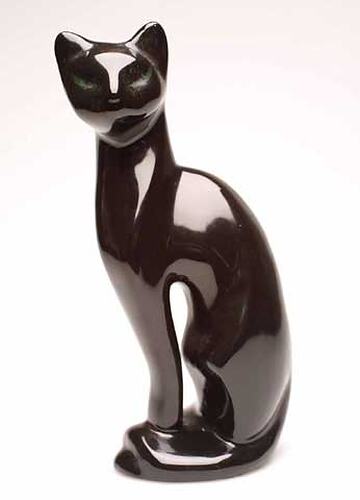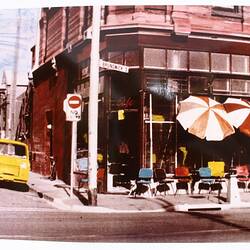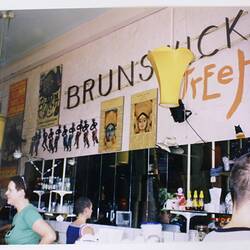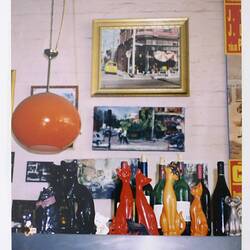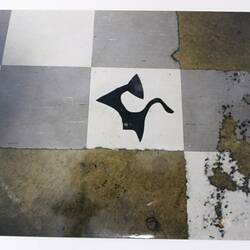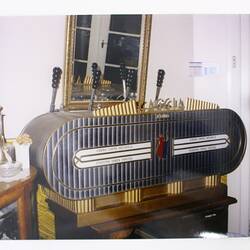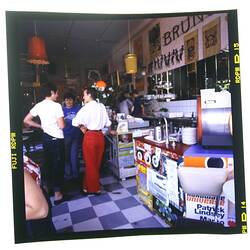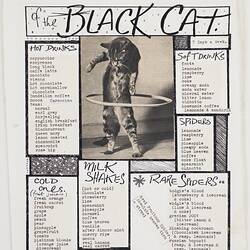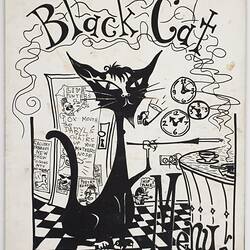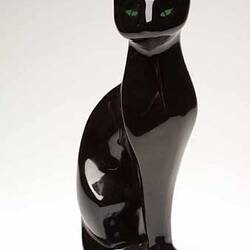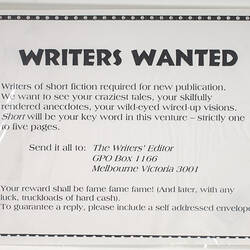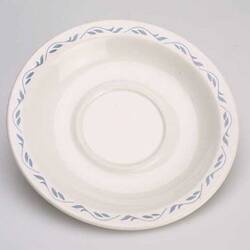The Black Cat Café, opened in 1982 by Henry Maas, Toni and Brian Edwards, was a retro 1960s style café on Brunswick Street, Fitzroy. The café was located at the corner of Brunswick Street and Greeves Street, in Beswicke Terrace.
At the time Brunswick Street was part of an industrial and working class suburb with few cafés and shops. The café developed into a trendy community-meeting place along the Brunswick Street shopping strip. Once established, the café's presence saw a transformation of the area, which had been increasingly populated by students, those seeking an alternative lifestyle and bohemians. The café catered for the young arty alternative set and was a significant contributor to the cultural and social changes that have made Brunswick Street what it is today.
This rich history is documented in a collection of photographs now held in the Black Cat Collection. When the Black Cat Café was first established there was no significant youth café culture in Melbourne. Maas and Edwards both wanted to create a café similar to those they had frequented in Europe, with music and vintage furniture and conversations a central focus. Maas decorated the café with objects found in opportunity shops, from friends and factories and with bric-a-brac from previous decades, particularly from the 1950s and 60s. The retro style of the café can be seen through the many decorative objects housed in the Black Cat Café Collection, including ornamental black cats. The owners used music to create a relaxed but stylish and sophisticated ambience.
The Collection contains a CD sample of the music played regularly in the café, which gave the café its ambience. In its heyday the Black Cat Café served inexpensive simple food, some with strange and exotic names, like a Nuclear Alaska, an ice cream sundae with the lot, and Widgies Blood and Bodgies Blood, both spiders with cola and ice cream with green or strawberry flavouring. The Widgies and the Bodgies were the name of young gangs of women and men respectively during the 1960s.
Food, however, was always a secondary focus. More emphasis was placed on the café being a place where people could come and drink coffee and discuss ideas. No prices were included in the menu until GST was introduced. There are examples of the café's menu in the collection. Most of the menus used over the years at the Black Cat were designed by Toni Edwards, with occasional guest artists such as Jeff Raglus, a musician from the Bachelors from Prague, who illustrated for Mambo surf wear for ten years.
The café welcomed customer participation, with a large notice board for customers to use to advertise rooms to let and objects for sale. This notice board, along with all of the last notices placed on it is part of the Black Cat Café collection. The notice board is an important example of the sense of community that was developed at the Black Cat Café.
In February 2001, Maas and Edwards closed the café and converted it into a European style cabaret, reminiscent of the place that Maas' parents had owned in St Kilda during his childhood. It retained the Black Cat name but all of the objects inside the café were sold off at auction, presided over by Maas, in February 2001. Some of these objects were donated to Museum Victoria, and have formed the Black Cat Café Collection. The collection comprises 29 objects, 72 images and 170 documents.
More Information
-
Keywords
Advertisements, Beverages, Brunswick Street Culture, Café Culture, Cafés, Cafeterias, Coffee Making Machines, Coffee Palaces, commercial art, Decorative Arts, Drinks, Entertainment, Entertainment Industry, Entertainment Venues, Food & Drink Consumption, Food Preparation, Food Technology, Housing, Leisure, Menus, Performing Arts, social history, Social Life
-
Localities
-
Authors
-
Article types
